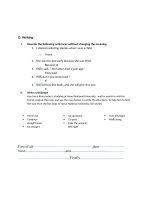Tips for IELTS Task 1
Bạn đang xem bản rút gọn của tài liệu. Xem và tải ngay bản đầy đủ của tài liệu tại đây (109.93 KB, 6 trang )
Exam summary
● The academic writing module takes approxiamtely 60 minutes.
● There are two tasks.
Task 1
This takes about 20 minutes. You write a report about a graph, table, bar chart or diagram, using a
minimum of 150 words.
You are marked on task completion and use of a range of vocabulary and grammar, organization and
development.
GOLDEN RULES
● In the IELTS test, do Task 1 first. There is a reason why it is Task 1! From the psychological point of
view, it gives you a sense of accomplishment when you have finished it.
● A common feature of the writing process is the concept of getting oneself going. With the shorter task
you can get yourself into your stride in writing. By the time you start Task 2, you will then be much more
alert and perform Task 2 much more efficiently.
● Spend 20 minutes on this task. A common mistake which candidates make is to spend longer on Task 2
and leave themselves 15 minutes or less to complete Task 1.
● Take Task 1 seriously, even though Task 2 carries double the marks.
● Skim the instructions and study the diagram. Use the general statement about the data to help you
interpret the graph.
● Spend the recommended 20 minutes as follows:
+ 2 - 3 minutes analysing and planning
+ 14 - 15 minutes writing
+ 2 - 3 minutes checking
● Check the values and numbers on the vertical and horizontal axes.
●Work out how many lines 150 words are in your handwriting, ex: if you write about 10 words per line,
then you will need to produce at least 15 lines. Aim to write no more than 170/ 180 words.
● Check that you have written at least 150 words. If you write less, it will affect your score.
● Compare general trends, differences etc. and support this with information from the diagram. Avoid
focusing too closely on the details.
● If you have more than one graph or chart or mixture, link the information.
● Make sure you write in paragraphs: an introduction, one or two paragraphs for the body of the text. Then
write a brief conclusion.
Graphs
How to write the introduction
● One sentence is enough for the introduction
● Replace words in the general statement with synonyms or paraphrases when you can.
● If you cannot quickly write your introduction in your own words, do not waste time. Write out the words
in the rubric, but remember to change them later.
● Do not write the word below from the rubric in your introduction.
● Use one of the following four prompts to help you write an introduction:
- The graph shows/ illustrates the trends in.... between... and...
1
- The graph gives / provides/ reveals/ presents information about (the differences / changes...)
- The graph shows that (there is a number of differences between...)
- The graph shows/ illustrates how the sales have differed/ changed...
● Vary noun phrases, ex: sales/ purchases of different cars; sales/ purchases of private vehicles; the
number of various types of cars sold/ purchased; the number of various types of cars sold/ purchased; car
sales/ purchases.
● Use general words for the introduction: information, data, difference(s), similarities, changes, trends,
results, percentages, figures, statistics, breakdown.
How to write the main part of the text
● Divide the text into 3 - 4 paragraphs, including the introduction
● Divide the information into broad/ general groups/ categories or trends
● Describe the main or most striking / significant/ noticeable/ outstanding/ remarkable feature(s) /
characteristics differences/ trends/ changes. Avoid writing lists of detail. Write about general trends and
support what you say with specific data.
● Describe the three general trends: is/ was upwards/ downwards/ flat or say what happened: ...(sales)
rose/ fell/ remained flat/ fluctuated...
● Use appropriate synonyms:
- rise(v): climb, go up, increase, improve, jump, leap, move upward, rocket, skyrocket, soar, shoot up, pick
up, surge, recover
- rise (n): increase, climb, jump, leap, pick up, surge (in)
- fall (v): collapse, decline, decrease, deteriorate, dip, dive, drop, fall (back), go down, go into free - fall,
plummet, plunge, reduce (only in the passive), slide, slip (back), slump, take a nosedive
- fall (n): decline, decrease, deterioration, dip, drop, plunge, free - fall, slide, slip, dive, reduction, slump
- fluctuate: (noun: fluctuations) be erratic, be fitful, vary, rise and fall erratically
- flat: no change, constant
● Add suitable adverbs: dramatically, erratically, gradually, markedly, significantly, slightly, slowly,
steadily.
● Add specific information or examples:
- (increasing etc) from...to...
- between...and...
- with an increase from....to.../ to...from...
● Use : .....followed by....to add more information.
● Add time phrases:
+ between..and...
+ from...to.... (inclusive)
+ at.../ by.../ in...
+ in the year (1994)...
+ during/ over the period .....to...
+ over the latter half of the year/ century/ decade/ period
+ over the next past/ previous five days/ weeks/ months/ years/ decades
How to compare and contrast
2
● Repeat the process for each general point, but vary the sentence structure, grammar and vocabulary.
● Use the comparing and contrasting language
● Use conjunctions like: while/ whilst/ whereas/ but
● Use linkers: however/ in contrast/ by comparison/ meanwhile/ on the other hand
● Focus on an item in the graph:
- As regards (sales), they...
- With regard to/ Regarding/ In the case of / As for/ Turning to (sales), they...
- Where....is/ are concerned, it/ they....
- When it comes to........., it/ they......
● Use the words and phrases to describe predictions:
- It is predicted / forecast(ed)/estimated/ projected/ anticipated that....will..
- ....will...
- ....will have....by...
- The projection is...for...to...
- ....is/ are predicted /forecast(ed)/ estimated/ projected/ anticipated to...
-... is/ are set to
● Use the present perfect to describe the recent past to the present: ....has risen...,etc.
● Write a conclusion. One sentence is enough. You can use the following phrase:
Generally.../ Generally speaking.../ All in all.../ On average.../ Overall../ It is clear/evident/ obvious that,...
● Other verb sequences stages you can use:
- rose from...to...
- ........rose....and increased from...to...
- ....rose.., increasing from...to...
- ......rose..., overtaking...in...and outstripping...in..
- Rising from...to...(sales) overtook...and outstripped...
-....... rose..., before leveling off...
- ........fell...., before rising....
- .......fell..., after rising...../ after rising...., ....fell...
- ....rose/ fell...from...to..., while/ whilst/ whereas/....rose/ fell...
Note how versatile the use of the gerund is. You can use it to explain, as part of series of events and as a
result.
Bar charts
● For bar charts that present data like graphs over a period of time.
● The survey took place in the past not the present, but you can use either the past simple or the present
simple to describe the data.
● Try to classify the items and divide them into groups rather than writing about each one in turn: the
(factors) can be divided into two main groups...
- Name the groups: .........namely/ those related to... and those (connected) with...
- Compare the two groups: .....of the two, the former is the larger...
- State an important feature in this group: with...being the most popular with 40 per cent
● Compare and contrast the other items. Use some of the following:
-more/ less than...
- (bigger) than...
- (not) as big as...
3
- twice as big/ much as...
- rather than...
- as against/ as opposed to/ compared with/ in comparison with...
- in (sharp) contrast to the biggest/ smallest (change)..
- more (women) cited/ achieved/ participated/ took part in/ were involved in...than...
- there were more (men) than (women) who...
● To quote from the results of the survey, you can use:
-...percent quoted/ cited/ mentioned/ considered.....as important...
-....was quoted/ cited/ mentioned/ considered as the most/ least important factor by...
- ...came top/ bottom/ second/ next, followed (closely) by ...at...and...respectively.
Pie charts
● Pie charts can be like bar charts except that various sections add up to 100%. There can also be a series
of charts where the data show trends.
● There is often both a graph and a pie chart and the two are related.
● Make sure you show the connection between the pie and the graph or bar chart rather than just listing the
data from the pie chart.
● Use the information regarding the graphs to describe trends.
● If you have a graph and a pie chart, describe the graph, if it is the most important. Then link the
information in the pie chart to the graph.
● Show that you are looking at the pie chart: From the pie chart, it is clear/ obvious/ evident that...
● Relate a particular item in the pie chart to an aspect of the graph/ chart: ...is related / connected to/ has
an effect on/ affects..., because...
● You can compare / contrast items: ...while...; in contrast,...
● You can use the pie chart to help you draw conclusions about the graph: The pie chart suggests that...
and show the relationship between the two.
● Always link data from different sources to each other.
Table
● A table can contain data like pie charts, graphs, and bar charts that are not related to a specific item in
the past. Follow the steps described for these charts.
● The presentation of information in tables can seem overwhelming. Don't panic! There is a simple way
round this. If the table gives a lot of data over a number of years, at the end of the line draw a rough graph
line to indicate the trend. Do this quickly for each item in the table. This means that you won't have to look
at each number every time you want to analyse a line.
● Because the numbers are given for each year; don't be tempted to include each individual piece of
information.
● Use general trends/ statements, backed up by data as in the graphs. Sometimes highlight special
changes/ developments.
Processes
● Follow the same initial steps for writing about a graph.
● In the introduction you can use: The diagram/ picture/ chart shows/ illustrates/ describes/depicts the
process of/ how...
● Find a starting point and write the process as a series of steps:
● Useful connecting words you can use are:
4
- Adverbs: first/ firstly/ first of all, secondly, thirdly, then/ next/ after that/following that/ following on
from this/ subsequently/ subsequent to that, finally
- Prepositions: At the beginning of...; At the end of...
● Use the following conjunctions to make more complex sentences:
- when/ once/ as soon as/ immediately
- before + clause or gerund
- after + clause or gerund
- where/ from where/ after which
● Other connecting devices you can use are:
- The first/ next/ final step/ phase/ stage is/ involves...
- After this step...
- Once this stage is completed...
- Following this...
● In sequences, you can also use the gerund to show development.
Tenses and voice
● Use the present simple to describe processes
● The agent is not usually mentioned unless a task is performed by a particular person.
● Use the passive voice if the process is describing something being made, like a book, ex: the book is
printed and then collated, after which it is bound.
● Use the active voice when you describe something which is happening: The moisture evaporates and
condenses on the...
● Be careful with singular and plural agreement in writing processes especially if you are using the active
voice.
● When describing a cycle, you can conclude: The cycle then repeats itself/ is then repeated.
Maps
● Follow the initial steps for analysing graphs and processes.
● If you are describing changes over a number of years, check the key carefully.
● Familiarize yourself with words showing location on the points of the compass: ... was constructed in
the north/ northwest; constructed north/ northwest of the city/ to the north/ northwest of the city, etc...
● Be careful with time phrases and tenses. With in, use the past simple passive.
The stadium was constructed in the year 2000.
With by, use the past perfect passive: The stadium had been constructed by the year 2000.
● Try to vary the structure of your sentences by putting the time phrase at the beginning and the end of the
sentence. The same applies to the locations.
● Some useful words and expressions:
- in the centre of/ next to/ adjacent to
- built/ erected/ replaced
- situated/ located
- changed into/ added/ gave way to/ became/ made way for/ converted
- saw/ witnessed considerable changes/ developments
● Use adverbs like moreover/ in addition...
● The use of while is common: while in 1995...by the year 2005...
Maps where you have to choose between proposed locations
● You are asked to choose which is the best location for a sports complex, etc.
5









